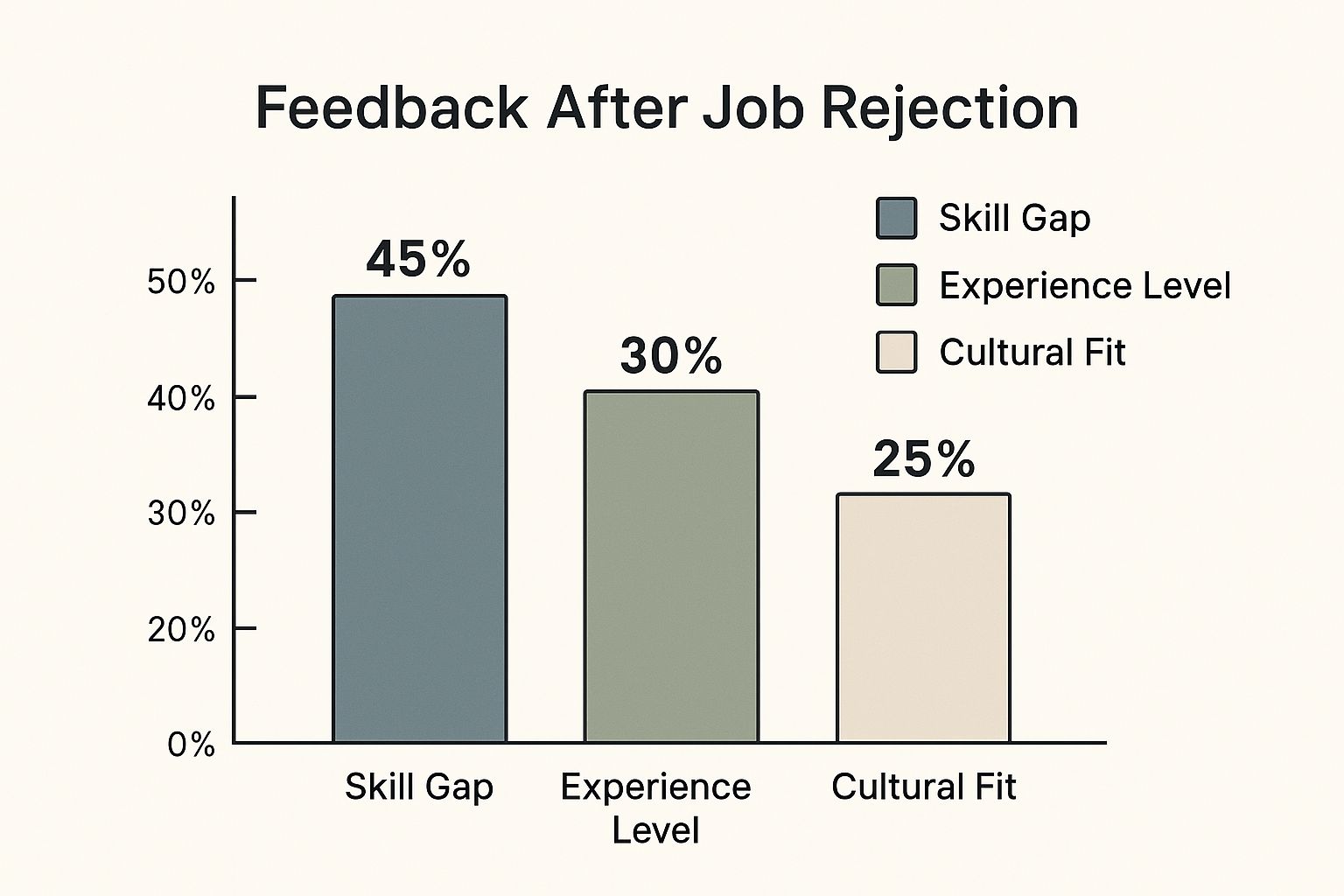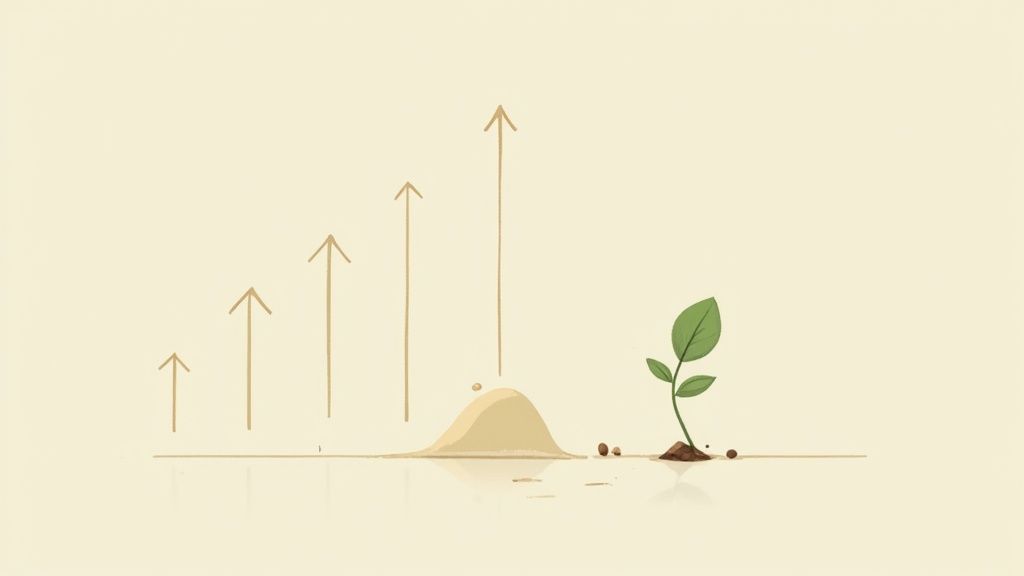
How to Handle Job Rejection and Stay Resilient
Published
The email arrives. That "we regret to inform you" subject line lands like a lead weight in your gut. What you do in the next 24 hours can make all the difference in how you bounce back.
The gut reaction is almost always the wrong one. You might want to fire back a desperate email, start endlessly doom-scrolling through LinkedIn, or fall headfirst into a pit of self-doubt. My advice? Do the exact opposite. Just. Stop.
Your First 24 Hours After a Job Rejection

This isn't about pretending it doesn't sting. It absolutely does. The key is to give yourself permission to feel that disappointment, but on your own terms. Set a timer, even. Give yourself the rest of the evening to be frustrated, angry, or just plain sad. Acknowledge the feeling, let it be there, and then get ready to move on.
By giving the emotion a specific, contained window, you prevent it from spilling over and poisoning your entire mindset for days.
Create a Mental Buffer Zone
Once you've let yourself feel the initial punch, it’s time to pivot. Hard. The goal here is to create a mental buffer zone, a deliberate break from anything job-search related. This is non-negotiable.
So, what does that look like in the real world?
- Get Physical: Lace up your running shoes and hit the pavement. Go for a long walk without a destination. Hit the gym and lift something heavy. Moving your body is one of the fastest ways to process stress and clear your head.
- Get Creative: Remember that hobby you keep meaning to get back to? Now's the time. Dust off your guitar, pull out your sketchbook, or cook a meal that requires your full attention.
- Get Lost in a Story: Put on a favorite comfort movie or binge a few episodes of a show that makes you laugh out loud. The goal is pure, unapologetic distraction, not productivity.
This isn't avoidance; it's strategy. You're consciously reminding yourself that your worth and identity are so much bigger than this one job application.
Resist the Reaction, Reframe the Narrative
Throughout these initial 24 hours, your brain will likely try to feed you a familiar script: "I wasn't good enough." Your job is to shut that down and replace it with a more accurate one: "It wasn't the right fit right now." It's a subtle but powerful shift that protects your confidence.
It also helps to zoom out and look at the bigger picture. Job hunting is tough. Period. Recruitment challenges are a real thing for companies, and with 1 in 5 unemployed Americans out of work for six months or longer, you're navigating a genuinely competitive field. This isn't a personal failure; it's a shared experience in a complex market. You can read more about the current disconnect between job seekers and employers on Indeed.
The Golden Rule for the First 24 Hours: Do not, under any circumstances, send an email. Wait. Let the emotional dust settle completely before you even think about asking for feedback or analyzing your interview. You want to act from a place of clarity, not raw emotion. That’s how you turn a rejection into a learning opportunity.
Alright, that initial sting of a "no" is tough. I've been there. But once the disappointment starts to fade, you have a choice. You can see that rejection as a closed door, or you can see it for what it really is: a valuable piece of data.
The trick is to shift your thinking from "I failed" to "What can I learn from this?" This is where feedback becomes your secret weapon, turning a setback into a stepping stone.
How to Actually Get Feedback After a Rejection
Let's be real: getting detailed feedback is hard. Most companies are cagey about it, worried about legal risks. So, your approach has to be smart, professional, and polite. Your goal isn't to argue their decision, but to make it incredibly easy for a busy recruiter to give you one or two helpful insights.
Timing is everything. Don't fire off an email the second you get the rejection. Give it a day. Let your own emotions cool down, and let the dust settle on their end.
Then, send a short, appreciative email. You're not questioning them. You're simply asking for a little guidance for your own professional growth.
Here’s a template I’ve seen work well. It's respectful and positions you as a proactive professional:
Subject: Thank You - [Your Name] for [Job Title] Role
Dear [Recruiter's Name],
Thank you again for the opportunity to interview for the [Job Title] position. I genuinely enjoyed learning more about your team and [Company Name].
While I'm disappointed, I completely respect and understand your decision. If you happen to have a moment, I would be incredibly grateful for any brief feedback you could share about my application or interview. Any insights you can offer would be so valuable for my professional growth as I continue my job search.
Thanks again for your time and consideration. I wish you and your team all the best in finding the right person for the role.
Best regards, [Your Name]
This approach works because it’s not demanding. You're framing it as a request for personal development, which is something most people are happy to help with if they can.
Reading Between the Lines of the Feedback (or Lack Thereof)
If you get a response, treat it like gold. Seriously. Even vague feedback holds clues. Recruiters often use polite, general language, so it’s your job to decode it.

As you can see, a huge chunk of rejections—a full 41.3%—come down to a mismatch in skills. This is your biggest clue. It often means there was a specific technical ability or software proficiency they needed that you didn't highlight or don't have.
To help you translate common rejection-speak, here’s a quick guide I’ve put together from years of coaching people through this process.
Common Rejection Reasons and Your Next Steps
| Rejection Reason | What This Could Mean | Your Actionable Next Step |
|---|---|---|
| "We've decided to move forward with a candidate whose skills more closely align with our needs." | You were missing a key technical skill (e.g., a specific programming language, software, certification). | Re-read the job description. Identify the "must-have" skills and find a course on Coursera or Udemy to fill that gap. |
| "The team was looking for someone with more experience in X." | Your experience level was too junior, or you didn't effectively showcase your relevant project experience. | Refine your resume to quantify your achievements in that area. Or, adjust your search to target roles that better match your years of experience. |
| "It wasn't a strong culture fit." | Your communication style, work preferences, or answers about teamwork didn't match what they were looking for. | Reflect on the company's vibe. Was it a fast-paced startup and you prefer structure? This might be a blessing in disguise. Practice articulating how you work best. |
| "We received a high volume of qualified applicants." | You were a great candidate, but so were others. Someone else just had a slight edge—maybe an internal referral or a niche skill. | Don't change a thing! This means your strategy is working. Keep applying to similar roles. Your "yes" is coming. |
Decoding feedback, or the lack of it, is a skill in itself. It’s about becoming a detective in your own job search.
But what happens if you hear nothing but crickets? Don’t sweat it, and definitely don't take it personally. A no-reply is not a judgment on you. Recruiters are juggling dozens of roles, and some company policies flat-out forbid them from responding.
When that happens, it’s time to do your own audit. Pull up that job description one more time and look at it with fresh eyes.
- Skill Gaps: Were there specific software platforms or certifications listed as "required" that you glossed over? This is the clearest sign of where you need to upskill.
- Experience Mismatch: Did the role ask for 5-7 years of experience and you have 2? Maybe it's time to filter your search for more appropriate, junior-level positions for a while.
- Interview Autopsy: Be honest with yourself. Replay the interview in your head. Did you freeze up on that behavioral question? Was your answer about handling conflict a little weak?
By turning the lens inward, you can always find a lesson. Every single rejection, feedback or not, gives you critical information to refine your strategy. It’s all part of the process that gets you one step closer to the right role.
Strengthening Your Job Search Strategy

When the rejections start to pile up, it’s a clear signal to step back and look at the bigger picture. This isn't about self-blame; it's about being strategic. The first move is an honest look in the mirror: are you even applying for the right jobs?
It’s tempting to fall into a "spray and pray" cycle, blasting your resume out for anything that looks remotely interesting. But a scattered approach usually just leads to more dead ends. Think about the feedback you've gotten so far. If you keep hearing hints about a skills gap or experience mismatch, that's your cue to recalibrate. Are you genuinely a good fit for these roles, or are you trying to stretch a bit too far?
Diversify Your Search Beyond Job Boards
If your entire job hunt lives on job boards, you're fishing in a very, very crowded pond. They’re a piece of the puzzle, for sure, but a huge number of jobs are never advertised publicly. Welcome to the hidden job market—getting in requires you to be proactive.
This means shifting from a passive applicant to an active networker. The idea is to build real relationships, not just ask for a job. I know it can feel daunting, but this is where the truly great opportunities are often hiding.
Here are a few ways to get started:
- Informational Interviews: Find people in companies or roles that fascinate you and ask for just 15 minutes of their time. Your goal is to learn about their journey, not to ask for a job. It's a fantastic, low-pressure way to get insider info and leave a great impression.
- Industry Communities: Dive into relevant Slack channels, LinkedIn groups, or professional forums. Don't just lurk—join conversations, share your insights, and become a familiar face. This is how you build a reputation as someone who knows their stuff.
Rejection is not the end of the road. Each "no" can teach you something valuable and help you grow personally and professionally, bringing you one step closer to the right opportunity.
Refine Your Personal Brand and Application Materials
Your professional brand is simply the story you tell about your skills and value. It needs to be clear, consistent, and memorable everywhere you show up online and on paper. A sharp brand is what makes you stand out.
Let’s start with your application documents. Your resume should never be a one-size-fits-all document. You have to fine-tune it for every single application. Use the job description as your cheat sheet—echo its keywords and highlight the exact skills they’re asking for.
Your cover letter is where you tell the story your resume can't. Don’t just list your past jobs. Connect your biggest wins directly to the company's problems and show that you're genuinely excited about what they do.
Beyond tweaking your resume, building your network can unlock doors you didn't even know were there. If you want to get better at this, learning how to master networking to boost your career can give you a practical playbook for making connections that count. And don't forget your LinkedIn profile; make sure it's complete with a professional photo and a headline that screams your value.
Building Resilience for a Tough Job Market
Let's be honest: navigating the job market today takes serious grit. It’s not a sprint. It’s a marathon, and one with a lot of unexpected hurdles along the way. Learning how to handle job rejection and keep going isn't just a nice skill to have—it's essential for anyone trying to land a great role.
That constant grind of applications, interviews, and then the waiting game can really wear you down. If you don't have a strategy to protect your mental well-being, burnout is a very real possibility. That’s why having a solid routine and setting intentional goals are your secret weapons.
Create a Structure for Success
A job search without any structure can quickly spiral into chaos. It starts to feel like a stressful, full-time job where your own self-doubt is the boss. The best way to fight back is to give your days (or weeks) a clear framework. This isn't about grinding out applications for 8 hours a day; it’s about finding balance.
Try dedicating specific blocks of time to different kinds of tasks. Here’s a simple structure I’ve seen work wonders:
- Morning (9 AM - 12 PM): This is for your high-energy work. Use this time to meticulously tailor your resume for a specific role, write a truly compelling cover letter, or do some deep prep for an interview you have coming up.
- Afternoon (1 PM - 3 PM): Switch gears to networking. Your goal could be as simple as reaching out to one new person on LinkedIn for a quick informational chat or just following up with contacts you already know.
- End of Day (3 PM onwards): Stop. Seriously. Shut the laptop and do something completely unrelated to your job hunt. This is non-negotiable for recharging your batteries.
A routine like this prevents the search from swallowing your entire life, which is absolutely crucial for staying sane and keeping your motivation high.
Key Insight: Your professional worth is not defined by an application's outcome. Resilience comes from separating your identity from your job search status and celebrating the effort, not just the results.
Celebrate Small Wins and Lean on Your Network
To keep your momentum, you have to change your definition of a "win." If you wait to celebrate until you get a formal job offer, you’re setting yourself up for a long, discouraging road. Instead, start recognizing and celebrating the small victories that happen all the time.
Did you land a first-round interview? That’s a massive win! It proves your resume is getting noticed. Did you have a fantastic networking call where you really connected with someone? That's a win, too. Acknowledging these milestones gives you the little bursts of positive reinforcement you need to keep pushing forward.
Remember, your professional network is more than just a list of potential job leads; it’s your support system. In early 2025 alone, the tech industry saw over 50,000 job cuts, a stark reminder of how unpredictable things can get. In a market like this, your network provides a much-needed dose of encouragement and perspective. You can find more details on how these global workforce shifts are shaping hiring trends on HireBorderless.com.
Simply talking to peers who get what you’re going through can make a world of difference for your confidence and focus. Don't go it alone.
Using Rejection to Find a Better Opportunity

It’s hard to believe when you’re staring at that email, but sometimes a rejection is a blessing in disguise. Seriously. That "no" can feel like a door slamming shut, but I've learned to see it as a nudge in a better direction—one that aligns more closely with my actual skills, personality, and what I really want out of my career.
This is your moment to reframe the whole experience. Think back to the interview. Did anything feel… off? Maybe the team’s vibe was a bit too competitive for your collaborative style. Or perhaps the hiring manager’s description of the daily grind didn't quite line up with your ambitions. These aren't just little things; they're valuable clues.
Key Insight: A job rejection often shines a spotlight on red flags you might have ignored. It’s a chance to get crystal clear on what you truly need in a role, a team, and a career path, steering you toward work that’s genuinely a better fit.
Let’s be honest. Were you truly fired up about that specific job, or were you just going through the motions because it seemed like the logical next step? I've been there. Sometimes, a rejection saves you from accepting a job you weren’t actually excited about in the first place.
Pivoting Toward a Better Career Fit
Once the sting of disappointment starts to fade, you can begin to use that clarity to your advantage. This is where you turn the lessons from that “no” into a concrete plan, sharpening your job search and aiming for something that truly fits. It's an active process, not a passive one.
Here’s how you can start making that pivot:
- Re-evaluate Your Deal-Breakers: Grab a pen and paper (or open a new doc) and list your absolute non-negotiables. Is it a flexible schedule? A manager who will actually mentor you? A specific company culture? Write it all down.
- Pinpoint What Actually Motivates You: What part of your work makes you feel alive? Is it cracking a tough problem, creating something from scratch, or leading a team to victory? Focus your search on roles that tap directly into those drivers.
- Explore Different Paths: Were you just lukewarm about the industry that job was in? Maybe this is the perfect excuse to finally explore that other field you've been curious about.
This kind of self-reflection is more important than ever right now. The job market is tough, with an estimated 407 million people expected to be looking for work globally by 2025. With that much competition, it’s easy to feel pressured into taking the first offer that comes along, even if it's a poor fit. For more on this, check out the global employment challenges at GlobalIssues.org.
By treating rejection as feedback instead of failure, you take back control. Each "no" isn't a final judgment; it's a piece of data that gets you one step closer to finding the company and the role where you won’t just work—you'll thrive.
Your Questions Answered
Let’s be honest, the job search process can feel like a maze, and a rejection can feel like hitting a dead end. It’s only natural to have questions about what to do next. I’ve been there, and I’ve coached countless people through it. Here are some of the most common questions that pop up, with practical answers to help you find your way forward.
Should I Reapply to a Company That Rejected Me?
Absolutely, you can—and sometimes should—reapply. But timing and strategy are everything. Don't just fire off the same application a week later.
Give it some time. A good rule of thumb is to wait at least six to nine months. This isn't an arbitrary number; it gives you a realistic window to build new skills, take on a new project, or gain experience that makes you a stronger candidate. It also gives the company time for its own needs, teams, and open roles to change.
When you're ready to try again, subtly reference your past interest. A quick line in your cover letter about your sustained enthusiasm for their mission shows you're persistent, not just applying everywhere. It's a move that hiring managers often respect.
How Do I Answer Why I Left My Last Job If I Was Laid Off?
When this question comes up, take a deep breath and remember two words: honesty and positivity. There's zero need to be defensive or launch into a long, complicated story. A straightforward, professional answer works best.
Try something simple and direct, like, "My position was part of a broader company restructuring and was unfortunately eliminated."
The trick is to pivot immediately. Don't linger on the layoff. Shift the conversation right back to why you’re so excited about this role and how your skills are a perfect match for what they need.
My Advice: Treat the layoff as something that happened to you, not something that is you. Frame it as a past event and steer the conversation toward the future you want to build with their company. It shows resilience and a forward-looking mindset.
Is It Okay to Connect on LinkedIn After a Rejection?
Yes! In fact, this is one of my favorite ways to turn a "no" into a future "yes." It's a classy move that keeps the door open. Just give it a day or two after getting the news to let the dust settle.
Never just hit the "connect" button and hope for the best. Always add a personal note. A short, polite message makes a world of difference.
Here’s a simple template that works wonders:
- "Hi [Interviewer's Name], thanks again for taking the time to chat with me last week. I genuinely enjoyed learning about [specific topic you discussed]. I’d love to stay connected and follow your work here."
This approach is professional, gracious, and doesn't ask for anything. You're not being pushy; you're building your network. You never know when that connection might lead to another opportunity down the road.
How Can I Stay Motivated After Multiple Rejections?
This is the toughest part. When you're dealing with one rejection after another, your motivation can tank. The secret is to stop focusing on the outcome (the job offer) and start focusing on your actions—the things you can actually control.
Instead of seeing the job offer as the only "win," create smaller, achievable goals. Think in terms of weekly progress. For instance, your goals could be:
- Send out three applications that are truly tailored to the role.
- Schedule one networking chat or informational interview.
- Spend an hour updating your portfolio with a new project.
Celebrate these small victories. Ticking these items off your list creates a sense of accomplishment and momentum. It’s this steady progress, not the final result, that will keep you going and prevent burnout during a long search.
Ready to find your next great role in the dynamic world of influencer marketing? Influencer Marketing Jobs curates the best full-time, contract, and remote opportunities to match your skills and career goals. Start your search and connect with top brands today.